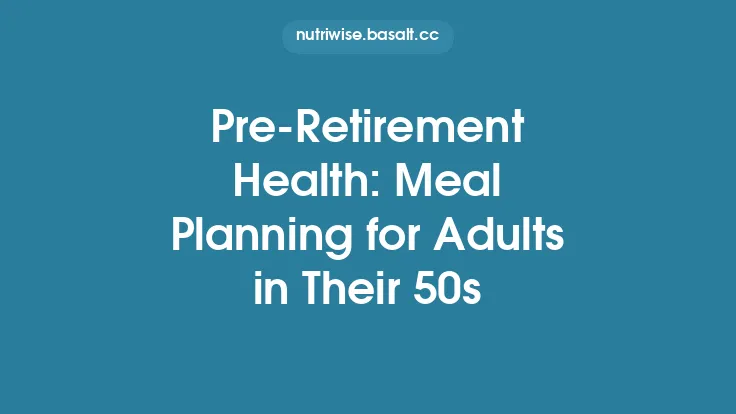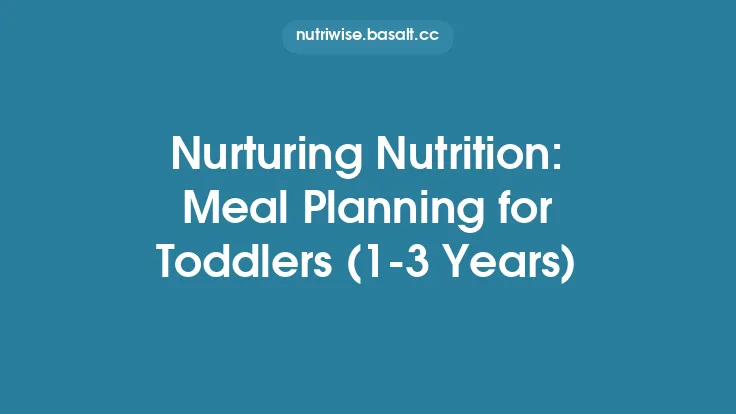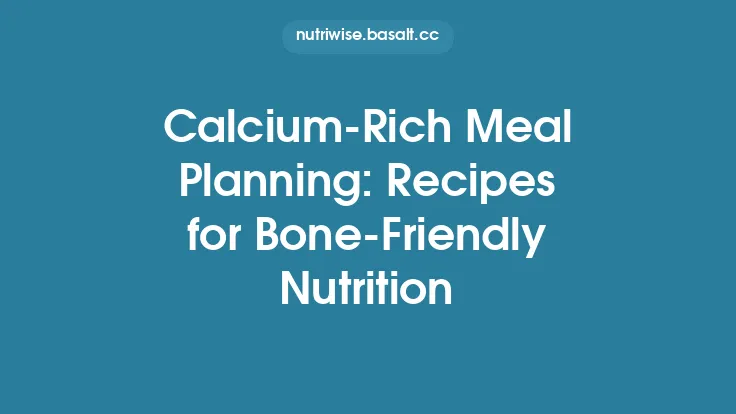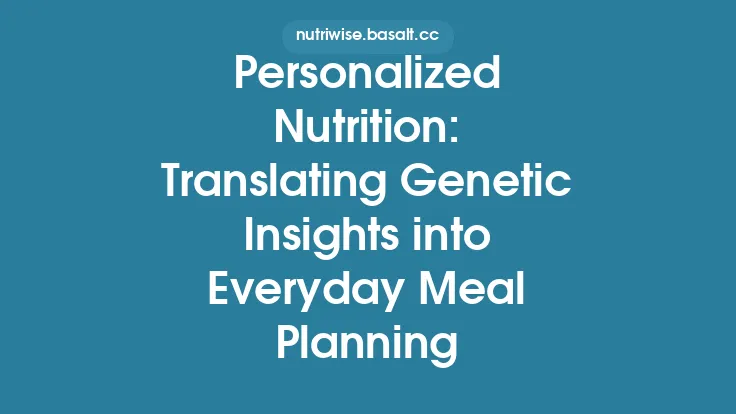Low‑Carbon Meal Planning: Strategies for Everyday Diets
*An in‑depth guide to designing daily menus that keep your carbon footprint low while still delivering nutrition, flavor, and variety.*
Understanding the Embedded Carbon in Food Production
Every food item carries a “carbon story” that begins long before it reaches your plate. From the energy used to cultivate the raw material, through the inputs of water, fertilizer, and machinery, to the processing steps that turn a seed into a ready‑to‑eat product, each stage adds greenhouse‑gas emissions. While the exact numbers differ by crop, animal species, and farming system, the overarching principle is clear: foods that require fewer external inputs and less intensive land use tend to embed less carbon.
Key factors that drive the carbon intensity of a food product include:
- Land use change – Converting forests or natural habitats into agricultural land releases stored carbon.
- Synthetic inputs – Production of nitrogen fertilizers and pesticides is energy‑intensive.
- Feed conversion – Raising animals that need to be fed large amounts of feed adds multiple layers of emissions.
- Processing intensity – Each additional processing step (e.g., refining, extrusion) consumes energy and often requires auxiliary inputs.
By focusing on foods that sit lower on this ladder of inputs, you can make a measurable dent in the overall carbon impact of your diet. Meal planning is the practical bridge that turns this knowledge into everyday action.
Core Principles of Low‑Carbon Meal Planning
- Prioritize Plant‑Forward Choices
Plant‑based ingredients generally require less land, water, and synthetic input per unit of nutrition than animal‑derived foods. Building meals around vegetables, grains, legumes, nuts, and seeds sets a low‑carbon baseline.
- Select Low‑Input Production Systems
When possible, choose items grown with minimal synthetic fertilizers, or those cultivated under regenerative practices that restore soil carbon. These foods often carry a smaller carbon imprint even within the same species.
- Emphasize Whole, Minimally Processed Foods
The more a product is transformed, the more energy it typically consumes. Whole beans, bulk grains, and fresh produce avoid the extra emissions associated with extensive processing.
- Balance Nutrition and Carbon Efficiency
A low‑carbon diet is not a compromise on health. Pair protein‑rich legumes with whole grains to achieve complete amino acid profiles, and incorporate a variety of colorful vegetables to meet micronutrient needs.
- Plan for Portion Control and Waste Prevention
Over‑preparing meals leads to food waste, which in turn releases the embedded carbon back into the atmosphere when discarded. Accurate portion sizing and thoughtful leftovers management are essential.
Building a Weekly Menu That Minimizes Emissions
Step‑by‑Step Planning Process
- Set a Nutritional Framework
Outline the macro‑ and micronutrient targets for the week (e.g., protein 0.8 g kg⁻¹ body weight, fiber ≥ 25 g day⁻¹). This ensures that low‑carbon choices also meet health goals.
- Identify Low‑Carbon Anchor Foods
Choose a handful of staple items that will appear repeatedly—such as lentils, quinoa, chickpeas, seasonal greens, and root vegetables. These become the carbon‑efficient backbone of your meals.
- Create Meal Templates
Draft a few flexible structures, for example:
- Bowl: Base grain + legume + roasted veg + herb sauce
- Stew: Legume or bean + seasonal veg + spice blend + stock
- Stir‑Fry: Tofu + mixed veg + whole‑grain noodles + light glaze
By reusing templates, you reduce the need for unique ingredient lists each day.
- Map Out a Shopping List
Consolidate the ingredients required for all templates, noting quantities that align with your portion plan. This prevents over‑buying and reduces the chance of items spoiling before use.
- Allocate Leftover Slots
Reserve at least one meal per day for repurposing leftovers—e.g., turning a roasted veg batch into a hearty soup or a bean salad into a wrap filling.
Sample Weekly Structure (Illustrative Only)
| Day | Breakfast | Lunch | Dinner | Leftover Use |
|---|---|---|---|---|
| Mon | Overnight oats with chia & berries | Quinoa‑lentil bowl with roasted carrots | Chickpea‑spinach stew | – |
| Tue | Whole‑grain toast + avocado | Leftover quinoa‑lentil bowl (cold) | Tofu‑broccoli stir‑fry with brown rice | – |
| Wed | Smoothie with kale, banana, hemp seeds | Mixed bean salad with citrus dressing | Sweet‑potato & black‑bean chili | – |
| Thu | Savory oatmeal with mushrooms | Leftover chili turned into stuffed peppers | Lentil‑couscous pilaf with roasted veg | – |
| Fri | Fruit‑nut granola with plant milk | Veggie‑hummus wrap | Mushroom‑tofu “bolognese” over whole‑grain pasta | – |
| Sat | Pancakes made from oat flour + fruit | Leftover bolognese as a baked casserole | Grain‑free vegetable curry with cauliflower rice | – |
| Sun | Scrambled tofu with herbs | Large mixed‑green salad with nuts & seeds | Roast veg & legume medley (batch for next week) | – |
The above layout demonstrates how a limited set of low‑carbon ingredients can be recombined across meals, keeping variety high while minimizing new purchases.
Leveraging Plant‑Based Proteins Effectively
Plant proteins are the cornerstone of low‑carbon meal planning, but they require thoughtful pairing to ensure a complete amino‑acid profile.
- Legumes (lentils, split peas, beans) – High in lysine, low in methionine. Pair with grains (rice, wheat, corn) to balance the profile.
- Whole Grains (quinoa, barley, oats) – Provide methionine and cysteine, complementing legumes.
- Soy Products (tofu, tempeh, edamame) – Naturally contain a more complete amino‑acid spectrum; they can serve as a single protein source in many dishes.
- Nuts & Seeds (hemp, pumpkin, chia) – Offer essential fatty acids and additional protein; use as toppings or blended into sauces.
Practical Tips
- Batch‑cook a legume base (e.g., a large pot of cooked lentils) and portion it for the week.
- Create a “protein pantry” of canned or dried beans, dried peas, and shelf‑stable soy products to reduce reliance on fresh animal protein.
- Incorporate fermented soy (tempeh, miso) for added flavor depth without extra processing steps.
Batch Cooking and Portion Management
Preparing larger quantities of a core component—such as a grain, legume, or roasted vegetable mix—once or twice a week can dramatically cut down the energy used for repeated cooking cycles.
- Choose a “big‑batch” vessel (e.g., a 5‑liter pot or a large roasting tray).
- Cook to a neutral flavor (light seasoning) so the base can adapt to multiple sauces or spice profiles.
- Cool quickly and portion into airtight containers (glass or stainless steel) for refrigeration (up to 4 days) or freezing (up to 3 months).
- Reheat only what you need using a stovetop or microwave, avoiding reheating the entire batch each time.
Portion control can be aided by using a kitchen scale or pre‑measured containers. This practice not only curtails waste but also ensures that each meal delivers a consistent nutritional load, preventing the temptation to over‑serve high‑calorie items.
Creative Use of Leftovers
Leftovers are a hidden carbon reservoir. Transforming them into new dishes extends the life of the embedded emissions.
- Roasted veg → Soup or puree – Blend with broth and herbs for a quick, comforting soup.
- Cooked beans → Dip or spread – Mash with olive oil, lemon, and spices for a versatile hummus‑style spread.
- Grain‑legume mix → Patties – Combine with a binder (flaxseed meal) and seasonings, then pan‑fry for veggie burgers.
- Stir‑fry veg → Fried rice alternative – Toss with a beaten egg or tofu scramble for a protein boost.
By assigning a “second life” to each component, you keep the carbon already invested in the food from being released as waste.
Incorporating Regenerative and Low‑Input Production Practices
Not all plant foods are created equal from a carbon perspective. Regenerative agriculture—practices such as cover cropping, reduced tillage, and holistic grazing—aims to sequester carbon in soils while lowering external input needs.
How to Identify Low‑Input Options
- Look for certifications (e.g., Regenerative Organic Certified, Certified Naturally Grown) that signal reduced synthetic input use.
- Seek out farmer‑direct channels (CSA programs, farmers’ markets) where growers can discuss their methods.
- Choose “heritage” or “heirloom” varieties that are often cultivated with fewer inputs and are adapted to local conditions.
While these choices may sometimes carry a modest price premium, the carbon savings per kilogram can be significant, especially for staple crops like wheat, oats, and beans.
Using Digital Tools and Carbon Calculators for Meal Planning
Technology can simplify the integration of carbon data into everyday menus.
- Carbon‑tracking apps (e.g., “FoodCarbon”, “Eaternity”) let you input ingredients and receive an estimated CO₂e value per serving.
- Spreadsheet templates can be customized with emission factors (kg CO₂e kg⁻¹) for each food item, automatically summing totals for a weekly plan.
- Meal‑planning platforms (e.g., “Paprika”, “Mealime”) often support custom ingredient lists, making it easy to swap high‑impact items for lower‑impact alternatives.
Workflow Example
- Create a master ingredient list with associated emission factors (sourced from reputable life‑cycle assessment databases).
- Enter your weekly menu into the planner, linking each dish to the master list.
- Run the calculator to see the total carbon footprint for the week.
- Iterate: Replace the highest‑impact ingredient with a lower‑impact counterpart and re‑run the calculation until you reach a target carbon budget.
Practical Tips for Grocery Shopping
- Shop with a pre‑written list derived from your meal plan; avoid impulse purchases that often lead to waste.
- Buy in bulk for pantry staples (dry beans, lentils, whole grains) to reduce packaging and transportation per unit weight.
- Select shelf‑stable low‑carbon foods such as dried legumes, whole‑grain flours, and nuts; these have a lower embedded carbon than many fresh items because they require less refrigeration and have longer shelf lives.
- Prioritize “ready‑to‑cook” whole foods (e.g., pre‑washed greens, pre‑cut veg) only when they save significant preparation energy; otherwise, whole produce tends to have a lower carbon profile.
Monitoring and Adjusting Your Meal Plan Over Time
A low‑carbon diet is a dynamic system. Regular review helps you stay on track and discover new opportunities.
- Monthly Carbon Audit – Use your calculator to compare the current month’s emissions with the previous one.
- Identify “Hot Spots” – Pinpoint ingredients or meals that consistently contribute the most emissions.
- Experiment with Substitutes – Swap a high‑impact component (e.g., a dairy‑based sauce) for a plant‑based alternative and re‑measure.
- Document Successes – Keep a simple log of meals that were both low‑carbon and highly enjoyed; this reinforces habit formation.
- Scale Up – Once comfortable, extend the approach to other household members or incorporate occasional low‑carbon “theme weeks” (e.g., “Legume‑Only Week”).
Closing Thoughts
Low‑carbon meal planning is less about radical dietary overhauls and more about intentional, incremental choices that align nutrition with climate stewardship. By grounding your weekly menus in plant‑forward, low‑input foods, mastering batch cooking, repurposing leftovers, and leveraging digital tools, you can transform everyday meals into powerful climate actions. The cumulative effect of these strategies—applied consistently across households and communities—has the potential to shift the carbon balance of the food system toward a more sustainable future.





